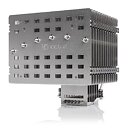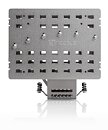Tuesday, June 15th 2021

Noctua Launches NH-P1 Passive CPU Cooler and LS-PWM Fan for Semi-fanless Systems
Noctua today released its much anticipated NH-P1 CPU cooler as well as the optional NF-A12x25 LS-PWM 120 mm fan. Custom-designed for fanless operation from the ground up, the NH-P1 is capable of cooling modern high-end CPUs with low to moderate heat dissipation completely passively in enclosures with good natural convection. For further enhanced performance or semi-passive setups that only spin up their fans when necessary, the NH-P1 can be outfitted with a low-speed, ultra-quiet 120 mm fan such as the new NF-A12x25 LS-PWM.
"The NH-P1 is our very first passive cooler, and it should be easy to see that we didn't just take a regular heatsink and omit the fan", says Roland Mossig (Noctua CEO). "A lot of engineering work went into designing this unit for fanless operation from the ground up and we're truly proud of the end result. In our completely fanless demo system, the NH-P1 cools an Intel Core i9-11900K running Prime95 at more than 3.60 GHz - this is a lot of processing power and a whopping 125 W kept in check with zero fan noise!"The NH-P1 isn't just a regular heatsink without a fan: featuring much thicker, much more widely spaced fins, it achieves both the mass and the minimal airflow resistance that are required in order to excel in natural convection cooling. In fully optimised fanless systems, the NH-P1 is capable of cooling high-end CPUs with low to moderate heat dissipation using natural convection only (see setup guidelines and CPU compatibility list). This makes it ideal for powerful builds that have no moving parts and run absolutely silent. Topped off with the new, Torx-based SecuFirm2+ mounting system, Noctua's award-winning NT-H2 thermal compound and a 6-year manufacturer's warranty, the NH-P1 is the ideal cornerstone for premium-grade fanless or semi-passive builds.
"While we're very excited about the possibilities that the NH-P1 opens up, we also need to stress that building a passively cooled system is not as straightforward as building a regular system. For optimal results, components must be selected more carefully, and certain principles should be respected", Roland Mossig (Noctua CEO) explains. "Therefore, we offer detailed setup guidelines, a build guide video tutorial, a list of recommended cases as well as an extensive CPU compatibility list that will help customers to get the best possible results."
In addition to the NH-P1, Noctua released the optional NF-A12x25 LS-PWM 120 mm fan, a low-speed, PWM-enabled variant of the award-winning NF-A12x25 that is ideal for enhancing the performance of the NH-P1 in semi-passive systems. At a maximum noise level of only 12.1 dBA, the NF-A12x25 LS-PWM is nearly inaudible but will still significantly boost the performance headroom of the cooler. As the fan stops at 0% PWM, it can easily be set up for semi-passive operation so that it will only spin up when necessary. This way, the system will work fanless most of the time but still provide the flexibility to make better use of the turbo modes of more powerful CPUs that require some extra airflow to be cooled adequately under full load conditions.
For more information, visit the product page.
"The NH-P1 is our very first passive cooler, and it should be easy to see that we didn't just take a regular heatsink and omit the fan", says Roland Mossig (Noctua CEO). "A lot of engineering work went into designing this unit for fanless operation from the ground up and we're truly proud of the end result. In our completely fanless demo system, the NH-P1 cools an Intel Core i9-11900K running Prime95 at more than 3.60 GHz - this is a lot of processing power and a whopping 125 W kept in check with zero fan noise!"The NH-P1 isn't just a regular heatsink without a fan: featuring much thicker, much more widely spaced fins, it achieves both the mass and the minimal airflow resistance that are required in order to excel in natural convection cooling. In fully optimised fanless systems, the NH-P1 is capable of cooling high-end CPUs with low to moderate heat dissipation using natural convection only (see setup guidelines and CPU compatibility list). This makes it ideal for powerful builds that have no moving parts and run absolutely silent. Topped off with the new, Torx-based SecuFirm2+ mounting system, Noctua's award-winning NT-H2 thermal compound and a 6-year manufacturer's warranty, the NH-P1 is the ideal cornerstone for premium-grade fanless or semi-passive builds.
"While we're very excited about the possibilities that the NH-P1 opens up, we also need to stress that building a passively cooled system is not as straightforward as building a regular system. For optimal results, components must be selected more carefully, and certain principles should be respected", Roland Mossig (Noctua CEO) explains. "Therefore, we offer detailed setup guidelines, a build guide video tutorial, a list of recommended cases as well as an extensive CPU compatibility list that will help customers to get the best possible results."
In addition to the NH-P1, Noctua released the optional NF-A12x25 LS-PWM 120 mm fan, a low-speed, PWM-enabled variant of the award-winning NF-A12x25 that is ideal for enhancing the performance of the NH-P1 in semi-passive systems. At a maximum noise level of only 12.1 dBA, the NF-A12x25 LS-PWM is nearly inaudible but will still significantly boost the performance headroom of the cooler. As the fan stops at 0% PWM, it can easily be set up for semi-passive operation so that it will only spin up when necessary. This way, the system will work fanless most of the time but still provide the flexibility to make better use of the turbo modes of more powerful CPUs that require some extra airflow to be cooled adequately under full load conditions.
For more information, visit the product page.





30 Comments on Noctua Launches NH-P1 Passive CPU Cooler and LS-PWM Fan for Semi-fanless Systems
The whole "increase performance with the optional fan" is pretty silly though, I mean sure you CAN do that but it should really not be advertised.
Laptop project?
I see it's (only) €109,90 in Germany.
In some workloads this might mean 3.5 GHz while in others this might still mean 5.2 GHz (this is just on one core though as all core boost is 4.8 GHz for a 11900k). Games for example don't draw that much power so you'll probably hit top boost speeds in them while something like Linpack will run on very low clock speeds if you want to stay under 125W. Most realistic workloads will be fairly close to the 4.8Ghz all core boost though as realistic workloads don't draw that much power.
We do not know what the load they mean is, but it doesn't matter since almost no consumer motherboard will respect the TDP and try to run in one of the turbo modes for as long as possible. Business-class motherboads will, however. What matters is adhering to specifications by both Intel and Noctua, and that's why Noctua used the frequency they used in the press release.
Is it mainly for "just because (we can)" as i think the situation where 100% passive cooled solution is *actually* required there are better specialty solutions available.
Which then brings me on to the madness of recommending a large, well-ventilated full-size ATX case for an IGP build that could just as easily be a NUC:
Throw in the need for a fan to make real use of Turbo/PBO and it's basically looking like a "buy one because you think it's neat, not because it's actually practical"
Honestly, the best thing about this product is the 12dBA fan they made specially for it. If you're going to run any fans, you want them to be quiet and I'm fairly sure 12dBA is low enough that I'm not ever going to hear it.
This Noctua heatsink seems small compared to the NoFan heatsinks. However, it looks like it's more compatible with smaller cases.